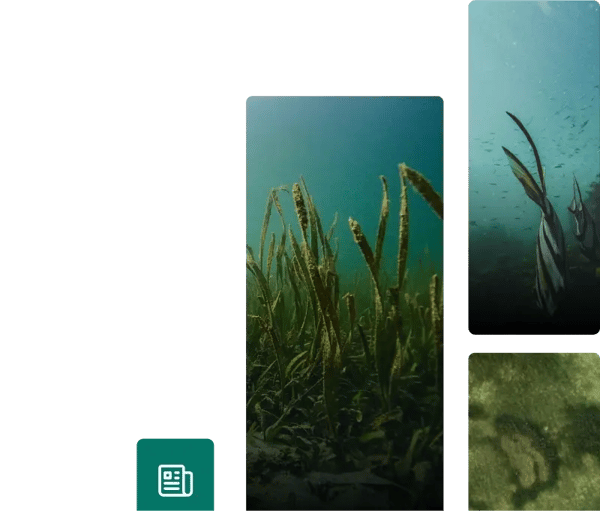“Nature-based Solutions provide sustainable, cost-effective, multi-purpose, and flexible alternatives for various objectives. Working with nature, rather than against it, can further pave the way towards a more resource-efficient, competitive, and greener economy.” (1) The European Commission
Today, our planet is facing a dual climate and biodiversity crisis. On the one hand, the climate emergency is threatening millions of people with extreme heat waves and sea level rises; on the other hand, human activities are impacting natural resources in terms of biodiversity loss, threatening millions of animal and plant species with extinction (2). This is why the fight against climate change and the decarbonization of our economy, while crucial, are not sufficient.
We need to shift to nature-positive models that protect and enhance biodiversity and implement solutions at the crossroads between fighting climate change and protecting and preserving our planet’s natural ecosystems. Nature-based Solutions (NbS) have the extraordinary ability to address our dual challenge.
What are Nature-based Solutions, and how do they work? ClimateSeed has prepared a brief and simple introduction to Nature-based solutions in which we answer the most important questions.
Introduction to Nature-based Solutions
The International Union for Conservation of Nature (IUCN) defines Nature-based Solutions as “actions to protect, sustainably manage, and restore natural or modified ecosystems that address societal challenges effectively and adaptively, simultaneously providing human well-being and biodiversity benefits” (3).
In general, “Nature-based Solutions” or “ecosystem-based approaches” are used to describe non-traditional and alternative approaches to address environmental issues that benefit biodiversity and support ecosystems.
According to the WWF, Nature-base Solutions (NbS) harness the power of nature to reduce greenhouse gas emissions. They are win-win solutions that involve protecting, restoring, and sustainably managing ecosystems to address society’s challenges and promote human well-being (4). NbS can be fundamental in climate change mitigation strategies as ecosystem services are used to reduce greenhouse gas emissions and to conserve and expand carbon sinks by increasing natural ecosystems’ resilience.
The fundamental concept underlying NbS is that healthy ecosystems can perform various services that human well-being depends on. These include storing carbon, controlling floods, and providing food, clean air, and water.
NbS is a specific concept that differs from traditional biodiversity conservation in that it supports biodiversity while aiming to address societal goals, including poverty alleviation and socio-economic development.
Why are Nature-based Solutions important?
The United Nations has stated the importance of Nature-based Solutions for climate and biodiversity to achieve the goals indicated by the Paris Agreement. Research has shown that NbS have the potential to provide over one-third of the cost-effective climate mitigation needed between now and 2030 to stabilize warming to below 2°C (5). Furthermore, The United Nations has predicted that adequate investment in NbS will reduce the financial consequences of climate change and help create new jobs and support a greener economy.
Nature-based Solutions can also help achieve the Sustainable Development Goals (SDGs) by promoting access to fresh water, improved livelihoods, and food security from sustainable food systems. Moreover, NbS provide a valid alternative to technological solutions, which generally rely on finite resources and often need to be improved and replaced (6).
Which concrete measures fall into the category of Nature-based Solutions?
Nature-based Solutions is a term that incorporates a wide range of solutions, including :
- The protection and management of natural ecosystems,
- Urban policies that include green infrastructures in cities,
- Land use policies that encourage a shift towards more sustainable agricultural practices (7).
What are the advantages of Nature-based Solutions? (NbS)
The main advantage of NbS is that they offer many co-benefits for the environment, economy, and society, especially at the local and regional levels (8). For instance, forest restoration increases CO2 sequestration, protects biodiversity, and may create local employment opportunities or protect local communities from flooding. Restored peatlands create habitats for endangered species, improve the water balance of entire landscapes, and significantly contribute to greenhouse gas emission reductions.
NbS have reduced upfront capital costs and are often more cost-effective in the long term than purely technological approaches. Furthermore, these solutions are more flexible and resilient and adapt more easily to the constantly changing climate. They increase the resilience of fragile nature reserves threatened by climate change and are a powerful tool to enhance much-needed public and private sector investment in biodiversity conservation.
Who finances Nature-based Solutions?
Funding for Nature-based Solutions can come from both public and private, national and international funds, and consists mostly of payments for ecosystem service programs, including the purchase of carbon credits, under the UN Framework Convention on Climate Change compliance (Green Climate Fund) or the Voluntary Carbon Market (private funding).
Funding mechanisms range from climate contributions, where project developers fund their projects through private voluntary contributions, to participatory budgeting, in which citizens can decide how a public budget is spent on NbS in urban areas, alongside several others (9).
How can we measure the effectiveness of Nature-based Solutions?
Measuring the effectiveness of Nature-based Solutions is not easy as appropriate indicators must be identified, and several interactive factors often influence effectiveness. Effectiveness should be measured case by case according to the perspectives and needs of every single project.
Assessment frameworks usually contain indicators on biodiversity and green space management. The IUCN is researching to create an international certification for NbS as, at the moment, no standard to assess the environmental impact of NbS exists.
However, when an NbS project contributes to GHG emissions removal or avoidance, international standards such as Gold Standard or Verified Carbon Standard (VCS) can certify the amount of CO2 emissions captured or avoided and issue verified carbon credits (VERs).
What are the current challenges for Nature-based Solutions?
As with every other solution, Nature based-Solutions can present some challenges, such as:
- Measuring and predicting their effectiveness as ecosystem response is more difficult to predict and assess (10).
- The difficulty in managing the projects, which require active cooperation and coordinated action.
- The poor financial models often make it difficult for projects to find appropriate financing.
In conclusion, while Nature based-Solutions present some challenges, they are extraordinary solutions to face the double climate and biodiversity crisis that we are facing.
ClimateSeed believes in the potential of Nature-based Solutions to tackle climate change, protect biodiversity, and help support local communities. This is why ClimateSeed has included several nature based-Solutions projects in its portfolio to help promote and support these valuable solutions in the fight against climate change.
Sources:
- The European Commission, Nature-based solutions, available at: https://ec.europa.eu/research/environment/index.cfm?pg=nbs
- World Economic Forum, The Future Of Nature And Business, New Nature Economy Report II, 2020
- IUCN, IUCN Global Standard for Nature-based Solutions, available at: https://www.iucn.org/theme/ecosystem-management/our-work/iucn-global-standard-nature-based-solutions
- WWF,Nature- based solutions, available at: https://wwf.panda.org/our_work/our_focus/climate_and_energy_practice/what_we_do/nature_based_solutions_for_climate/
- UN Global Compact, Nature-Based Solutions to Address Climate Change, available at: https://www.unglobalcompact.org/take-action/events/climate-action-summit-2019/nature-based-solutions
- Silva Mariana, What are nature-based solutions and why do they matter?, 2019, available at: https://www.climatechangenews.com/2019/12/09/nature-based-solutions-matter/
- The European Commission, Biodiversity and Nature-based Solutions, Analysis of EU funded projects, 2020, available at: https://op.europa.eu/en/publication-detail/-/publication/d7e8f4d4-c577-11ea-b3a4-01aa75ed71a1
- Nature-based approaches for climate change mitigation, available at: https://www.ecologic.eu/sites/files/publication/2014/eco_bfn_nature-based-solutions_sept2014_en.pdf
- The European Commission, Biodiversity and Nature-based Solutions, Analysis of EU funded projects, 2020, available at: https://op.europa.eu/en/publication-detail/-/publication/d7e8f4d4-c577-11ea-b3a4-01aa75ed71a1
- Chausson A., Seddon N. et al., Understanding the value and limits of nature-based solutions to climate change and other global challenges, 2020, available at: https://royalsocietypublishing.org/doi/10.1098/rstb.2019.0120
Share this
You May Also Like
These Related Stories

Improved Forest Management & the Sustainable Development Goals

Blue Carbon: Policy and Conservation Initiatives


